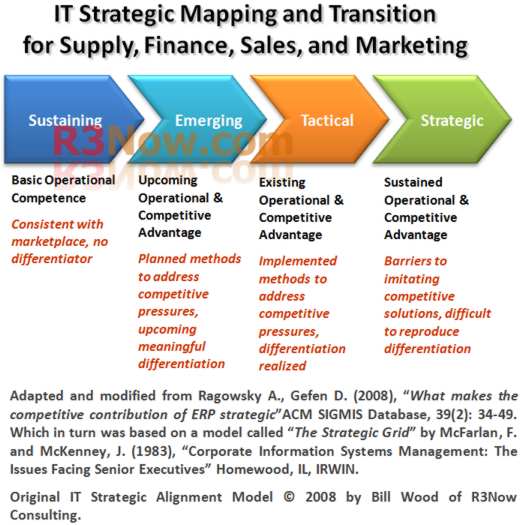We hear it almost every day: IT Strategy, Business Strategy, strategic customer accounts, strategic widgets, etc. Strategy is applied to so many areas with so little understanding that the word has almost become meaningless.
I decided to build my own research-based model around strategy because of all of the buzz and the lack of clarity or simplicity. I wanted to answer a key question: How do you determine if you are being strategic or just using tactics you are calling a strategy?
What I discovered is almost universal confusion of what is tactical and strategic. The reason is simple: strategy is hard. Also, strategy depends on your position and direction. You can take a more limited and focused approach to produce tactical advantages, and in turn many refer to a tactical advantage as a strategy. Here is an oversimplification:
- Tactics: execution steps that provide short-term wins (short-term competitive advantage)
- Strategy: methods, which includes tactics, to prevent opponents from winning (mid- to long-term barriers to competition)
Tactics are often related to operational effectiveness, or how well you execute in a given area or context. You gain an advantage for a period of time, but competitors reproduce your improvements (tactics). Strategy is more directly related to market strength, as it determines how well you engage, penetrate, and hold markets compared to your competitors.
For an illustration of tactics vs. strategy, hockey player Wayne Gretzky said, “I skate to where the puck is gonna be, not where it has been.” Most hockey players ran to the puck where it was in play, just in time to see it passed to another player. Gretzky would go to where the puck was going to be and was prepared for the puck when it arrived.
A Simple Sports Illustration of Strategy Layers
To understand the strategic perspective, consider a football team. The Quarterback’s strategy is, “How do I win this game?” To the coach, the quarterback’s strategy is a tactic because his strategy is, “How do I get my team to win the season?” To the owner, winning the season is a tactic because his strategy is, “How do I fill the seats, sell advertising, and create a long-term winning team that brings in revenue?”
The key to successful strategy is in understanding where you are in relation to the broader organization and goals. Then, determine your unique strategy.
Do You Have an IT Strategy?
At the risk of offending my CIO and CTO friends at some pretty large companies, I am not sure if a genuine “IT Strategy” exists. Unless you are in a Technology business, I don’t think the term applies.
There is, however, an IT-Enabled Business Strategy. By ensuring IT is focused on Business Strategy, the IT organization becomes a strategic business asset. Focusing on how IT can help a business become more competitive now (tactical) by gaining market share demonstrates IT value. As you focus efforts at creating barriers to competition (holding market share), IT becomes strategic. A business example would be the following:
Customer acquisition is more like a tactic (an event), while customer retention and selling into your customer base is strategic.
What Does an IT Strategy Look Like?
If your IT organization can engage, penetrate, and hold the internal IT market within your enterprise, you might have an IT Strategy. Like any marketspace, if you are doing this through monopoly power, then you are not strategic but rather rely on enterprise enforcement to ensure your monopoly position. It is only a matter of time, or a change in leadership, before this monopoly will break up. Business units across various enterprises are taking their own budgets and bypassing the “IT monopoly” through BYOD (Bring Your Own Device), Cloud, etc.
If you are not operating in a monopoly environment, the way to engage, penetrate, and hold the IT organization’s “market” is to deliver lasting and hard-to-duplicate value to the greater enterprise.
Conclusion on Building a Strategy
This short post only scratches the surface of strategy development. However, if you want to become strategic, you must learn your enterprise’s competitive landscape. If you can’t identify your enterprise’s marketspace competitive pressures, and understand your place in those areas, then real strategy will be elusive if not impossible. In fact, even genuine tactical advantage will be extremely difficult. After all, what are you trying to gain competitive advantage against?
If you want to make an SAP, ERP, or other IT project strategic, you must understand how to design for business value and competitive advantage.







